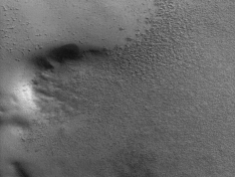Footprints of the HiRISE observations
I’ve been learning to use JMARS (Java Mission-planning and Analysis for Remote Sensing) to plot the coverage of the CTX images for Planet Four: Terrains. JMARS is a really nice tool for overlaying observation footprints and different maps and datasets on top of each other for Mars and other planets.
I decided to take a look at what the HiRISE Season 2 and Season 3 observations, that the science team is currently working on writing up, look like on a map of the South Pole when you plot their physical coverage on the pole . You can really see the overlap and what a small area that HiRISE covers compared to CTX.
Here’s the footprint HiRISE observations for Seasons 2 and 3 outlined in red on the elevation and topography map of the Martian south pole (latitude and longitude lines are in 10 degree intervals).

Here’s a zoom in on one of our favorite regions, Inca City. You can really see the repeat coverage outlined in white in this case.

Here’s another zoom in of a different area, where you can see multiple seasonal targets outlined in red:

For comparison here’s the footprints of the first set CTX images (latitude and longitude lines are in 10 degree intervals). The colors represent geologic units, but for this comparison we’re focusing on spatial distribution and coverage.

More Examples of Baby Spiders
I’ve been looking at the results of my pipeline to combine the many classifications we get for each Planet Four: Terrains subject (CTX subimage) and also the subjects you’ve marked with Talk hashtags in preparation for picking a list of final targets for the HiRISE seasonal campaign. I thought I would share with you some great examples of images with baby spiders that I found. If you’re having a hard time identifying spiders from baby spiders or a channel network, here’s some advice from our site guide:
- Legs longer than the size of the center pit: It’s a spider
- Only a pit or has tiny legs shorter than the size of the center pit: It’s a baby spider
- No discernible pit and no centralized pattern but more grid or network like: It is a channel network
Gallery of Subjects With Baby Spiders – click an image below to get the slide show – Enjoy!
WeMartians Interview: Citizen Science on Mars
WeMartians is a brand new podcast aimed to engage the public in the exploration of Mars. The latest episode is about citizen science on Mars with Michael talking about Planet Four and Planet Four: Terrains. Listen to Michael (and cameos of other familiar Zooniverse voices) below or on the WeMartians website.
Countdown to Picking New Proposed HiRISE Targets
One of the key goals of Planet Four: Terrains is to identify new areas of interest to observe with HiRISE during the seasonal processes campaign so that we better learn about the carbon dioxide geyser process and about how and were spiders and related channels form. You can read more about the particular goals of Planet Four: Terrains here. Over the months we’ve read the discussions and comments on Talk and been making a list of regions to consider from your observations. We’re really intrigued by many of the things you’ve all spotted. Which is fantastic news! Talk has been a huge asset for this work, but we’re also using the classifications from the classification interface as well. I’ve spent the past three weeks putting together a software pipeline to take the multiple classifications per CTX subframe (typically 20 people review each subject image) to identify spiders, baby spiders, channel networks, craters, and the Swiss Cheese Terrain.
Now that the machinery is all together combined with the interesting gems on Talk we’re ready to make our list of proposed new HiRISE monitoring targets. By April 20th I aim t provide the rest of the Planet Four: Terrains science team a compiled list of locations for them to review. Then Anya will input these into the HiRISE planning system where they will be considered with the HiRSE team’s science goals and eventually Candy who wears many hats including Deputy Director of the HiRISE camera and lead of the seasonal processes campaign will prioritize these new areas with the already existing targets in the seasonal processes observing program. We aim to be ready for HiRISE’s first attempt to image the South Pole which is coming up in about 60 days or so.
This is where you come in. We have new images of different areas on the site now. There have already been some interesting images from this set I’ve forwarded to the rest of the team after seeing discussions on Talk. Let’s make a push to classify as much of the new data set as possible before the 18th of April. The more subjects reviewed the greater chance to include those areas at the start of the monitoring campaign. Not to worry though, we’ll also have a few chances to include additional targets later in the Spring Season to the HiRISE monitoring campaign if need be or to the next one.
If you have a free moment, classify an image or two at http://terrains.planetfour.org








